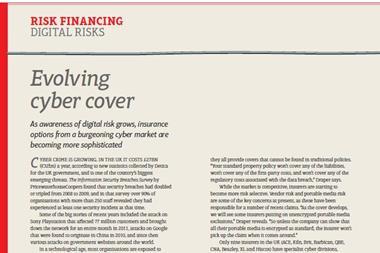Initial estimates peg the insurance loss at between $15bn and $35bn
Early estimates suggest insured losses from the Japanese earthquake (excluding tsunami-related losses) could be between $15bn and $35bn.
RMS issued the following catastrophe report on the event.
On Friday, March 11 a powerful magnitude 8.9 Mw (moment magnitude) earthquake occurred offshore the east coast of Honshu, Japan (02:46pm local time). The Unites States Geological Survey (USGS) has released a preliminary epicentral location around 80 miles east of Sendai and approximately 231 miles northeast of Tokyo, and reported a fixed focal depth of 15.2 miles. Because of the size of the event, the amount of energy released, and the exact location (depth and coordinates), the effects of the earthquake are difficult to calculate immediately after the event.
“The subduction zone along the Pacific coast of Honshu has always been something of a puzzle in terms of earthquake hazard,” said Dr. Robert Muir-Wood, chief research officer at RMS. “The last major subduction zone earthquake along the Pacific coast to the east of Tokyo was in 1677. While this earthquake caused a major tsunami, the shaking from the earthquake inland was not so strong. In 1896 and 1933, there were major earthquakes in the northern part of the subduction zone, off Northeastern Japan, which generated very large tsunamis.”
“There remained a seismic gap of about 500-600 km on the subduction zone – the northern two thirds of which now appears to have broken. This means there could be potential for another major earthquake to occur along the adjacent southern section of the subduction zone, located to the east of Tokyo and Chiba, although it’s impossible to say when, ” added Dr. Muir-Wood.
Aerial footage of the area shows inundation in many northern coastal towns after the tsunami, approximately 10m in height, struck the coast. Water was seen rushing up the Natori River in Sendai and flooding low lying agricultural land. In Kamaichi, in northern Japan, a smaller tsunami swept boats, cars and trucks away.
Japan Insurance Summary
Japan ranks as the fourth largest non-life market after the US, Germany, and the U.K., with direct non-life premium income amounting to JPY 10.8trn (USD 104.9bn) in the year ended March 31st, 2009. Approximately 70% of this income is derived from personal lines. Despite the size of the market in gross premium terms, insurance penetration and density is very low when compared to leading western markets, particularly in commercial and industrial lines.
It is estimated over 50% of households have building insurance and 40% of vehicle owners hold motor damage policies. Earthquake, including shock, fire, and tsunami, is available as an optional peril on properties covered by a basic household policy. In 2010, it is estimated less than 50% of policy holders insured through conventional insurance companies took this option. These figures do not include co-operative household policies, which although excluded from The Law Concerning Earthquake Insurance (1966), tend to offer earthquake coverage automatically and are the largest provider of domestic earthquake insurance.
Commercial and industrial lines are significantly under-insured, with many large corporations insuring their properties on an indemnity basis only, with no loss of profits or earthquake insurance. Many small to medium sized business are completely uninsured.
All household and most commercial fire polices are automatically extended to include earthquake fire expenses insurance.
Electricity Supply
The extent of disruption to the electricity supply is not yet clear, but it is likely to be severe in regions inundated by the tsunami. It has also been reported that 4 million homes in Tokyo suffered power outages. Isolated reports have been received from affected facilities. Reactors at Hokuriku Electric Company’s Onagawa nuclear facility in northern Japan shut down automatically after the quake, although no nuclear leaks were reported. Electric Power Development (J-Power) also suspended operations of its thermal power plant in Isogo, Yokohama.
Commercial and Industrial
Car manufacturing plants, electronics factories, and oil refineries have suspended operations across large parts of Japan. Nissan and Toyota have closed several of their facilities.
Sendai and the surrounding region host major industrial and manufacturing areas, with many chemical plants. The extent to which these have been damaged is not clear, but there are numerous reports of disruption, in part because of damage to the power grid.
Japan’s largest oil refiner has suspended operations at three refineries in Sendai, Kashima, and Negashi.
Additionally, a major fire has broken out at an oil refinery in Chiba, east of Tokyo, and smoke has been reported from Yokahma’s Isogo area. Several areas in the port were flooded, including the carpark of Disneyland Tokyo. Smoke was seen rising from at least 10 locations throughout the city.
Transport
Sendai Airport was inundated by the tsunami triggered by the quake. The airport ramp and surrounding runways were completely flooded, but there were no obvious signs of damage to terminal buildings. Haneda and Narita Airports, which serve Tokyo, were also closed after the earthquake struck. Neither has reported major damage and Haneda has already reopened. A spokeswoman has confirmed Narita is able to re-open, but has not stated when this will happen.
Local transport links in the Sendai region have been severely disrupted by the tsunami, with reports of damaged bridges, overpasses, and rail links. Bullet train services north of Tokyo were also suspended.
The tsunami also caused severe damage to Sendai port and there are reports that all ports in the country have been closed.



















